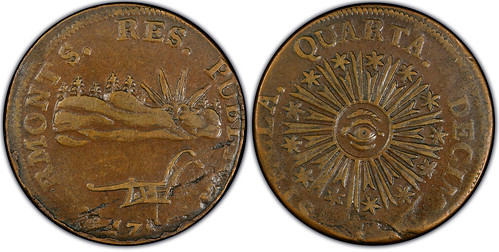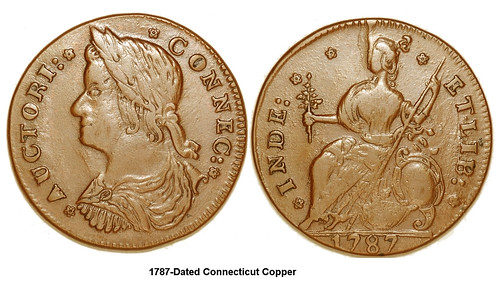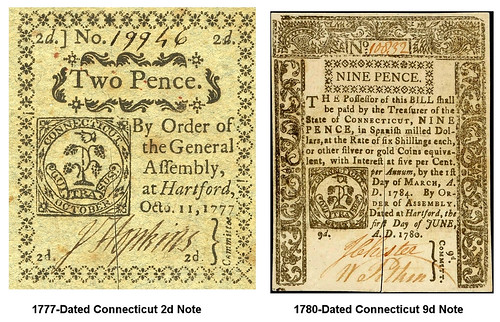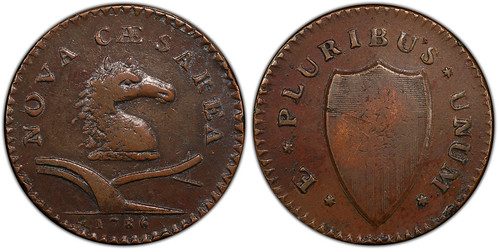
PREV ARTICLE
NEXT ARTICLE
FULL ISSUE
PREV FULL ISSUE
MORE ON CONFEDERATION-ERA COPPERSLast week, we discussed a PCGS article redefining New Jersey, Vermont, Connecticut, and other confederation-era ‘coppers' as 'halfpennies'. Colonial Coin Collectors Club (C4) President Chris McDowell wrote "one of the authors has already disavowed the work and requested his name be removed." When I drafted the E-Sylum piece I sent a copy to all of the listed authors and one of them (Jeff Rock) confirmed to me that he'd asked PCGS to remove his name. Later the lead author Craig Sholley shared email messages confirming that all listed authors had earlier been contacted. However, over a year had passed since then. Here are comments on the topic submitted by Jeff and others. -Editor Jeff Rock writes: "The PCGS article on renaming much of the undenominated coins made in colonial and early America as halfpence, ran with my name as one of the co-authors. I read over a draft of this article a year ago and made some minor suggestions, but did not do any actual writing on the piece, nor did I agree with its findings. Nothing was done with this article for a year, and I assumed the authors were reworking it, so it was a bit of a surprise to see it published. As I did not agree with the conclusions, I have asked that my name be removed as a co-author, though that has not yet been done. My disagreements with this article are shared by many in the colonial field. In most of the legislation authorizing the state copper coinages, as well as in contemporary newspaper accounts, these coins were referred to as coppers - not halfpence. It seems that governmental authorities actually went to great pains to NOT call them halfpence, and to me that is striking. The authors conflate copper and halfpence and claim that this is the same as us doing the same with the word "nickel" to refer to a five-cent piece - which would be an accurate comparison if they showed that the legislation for the five-cent piece actually called them nickels, exclusively. This is not the case, and I think we need to give weight to what people at the time called these coins - which was "coppers." The lack of a specific denomination would have allowed these to have a value that was not tied directly to the British and Irish halfpence that also circulated in colonial America (in both real and, more often, counterfeit form), and would allow the various states to change the rate their own copper coin was accepted at. The creation of the denomination "1/2P" on slabs was intended to refer to an American halfpence as opposed to the British and Irish halfpence (which are abbreviated "1/2d" - but there is obviously not room on the slab to make this distinction and will cause endless confusion. The authors originally proposed "A1/2P" as the denomination, which may have helped matters a bit, though it is still incorrect to assume that this wide variety of coinage types all circulated at the same value, this mythical American Halfpence. While I doubt many colonial specialists will care if the "1/2P" designation is used on slabs, I also doubt that many of us will refer to the pieces in our collections by that made-up denomination. To us they will remain coppers." Julia Casey writes: "This article goes to great pains to prove that halfpence are coppers. To prove this, the authors quote primary sources such as Scottish and Canadian newspapers, British citizens, and even a claim made by Denmark. While these sources may prove that British halfpence are coppers, this was never in dispute. The great fallacy of this article is to declare that since all halfpence are coppers, then all coppers must be halfpence. State coppers are not halfpence. "I also take issue with the word "coppers" relegated to "slang" like nickels. State coppers had a denomination. It was a variable denomination, which was always a fraction of a shilling. A "Connecticut copper" or a "Jersey copper" are the denominations of these coins. The "uneducated public" and the American everyman were fully aware of this." Randy Clark writes:
"I recently read the latest press release from PCGS making a business decision to rebrand confederation-era
state coppers as American "PCGS may be looking at the confederation era through modern eyes, trying to enforce numismatic denomination order for that period. In the 18 th century, prior to the confederation era, individual colonies printed specific denomination paper currency, but did not make domestic coins. Instead, each had to decide how to value a plethora of foreign circulating coinages, using an exchange rate from their local currency to the world's currencies (controlled by individual legislatures). The use of exchange rates continued through the confederation era and only ended with the US Constitution and a countrywide, decimal based currency system. Because these 18 th century colonies, later states, did not make domestic coinages – they found it difficult to assign crisp local denominations to whatever coins were being circulated. "My area of focus is Connecticut coppers, so I will confine my comments to that state's coining efforts. From 1709 to 1780 Connecticut issued paper currency in denominations of Connecticut pounds, shilling and pence. Denominations varied by year of issue, but there were minor notes in Connecticut pence (d) up to major notes in Connecticut pounds (£). In the legislative acts of 1780, Connecticut defined their currency notes as payable in Spanish Milled Dollars, or coins equivalent, so it is clear they were aligning the state's currencies to Spanish silver, rather than anything British. One Spanish Milled dollar was worth 6s in Connecticut money of account.
"Connecticut's colonial and confederation era exchange rate with British money was 1 shilling and 4 pence
of Connecticut money per British shilling. Which means a British halfpenny (valued at 24/s in England)
circulating in Connecticut was valued at 18/s in Connecticut money. This clarifies why it was called a
"In 1785, when Connecticut authorized its own coppers, their intent was not to add yet another
denomination to the crazy mix of coppers already in play. And since they had issued paper currency as
recently as 1780, they were not intending to release a new form of legal tender. The legislative proposal
was to tighten up the local spare change medium with more uniform and predictable Connecticut made
versions. They chose a
"In 1787, the devaluation of coppers (the so-called
"The point is that Connecticut was not coining local currency halfpence and certainly was not making British
halfpence. Given their experience with paper currency issues, both minor and major, Connecticut's
Legislature and Treasury knew how to define denominations with specificity. They authorized Did the New Jersey Colonial Copper Have a Denomination? "The law empowering Walter Mould, Thomas Goadsby and Albion Cox (6/1/1786) …to strike and coin in Copper, for this State, a Sum equal in Value to Ten Thousand Pounds at fifteen Coppers to the Shilling (3 million Coppers)" is found in Early Coins of America, Crosby, p.278. The value of the copper is 1/15 shilling or 0.8 pence. It is inconvenient to call 0.8 pence a denomination, but certainly not correct to call it a halfpenny. These NJ coppers were struck to replace underweight counterfeit British halfpence and other light weight coins with a trusted copper.
"As to weight, Crosby, p.278 states the Act "The unauthorized practice of overstriking underweight coppers with the NJ design caused the NJ Assembly to vote to no longer accept NJ coppers in payment as of 6/10/1790, ending its special tax payment status and premium value. In the copper panic that started in 1789, coppers as a type were valued at 48 to the shilling or worse.
"The conclusion is that the denomination of a NJ copper is 1/15 of a shilling, but the commercial value declined substantially once the State would not accept the coppers to pay taxes. This is a similar situation to the Higley coppers legend to Mike Wierzba writes:
"Recently an article came out on behalf of PCGS written by a group of authors, who are highly
respected in numismatics, reclassifying many confederation-era State Coppers and other issues
as
"In this case, however, I must disagree with the article published by my esteemed colleagues.
My area of expertise primarily focuses on NJ coppers, so I will stick to that series here. When
the contract for striking NJ coppers was written, as well as the legislation printed to authorize
NJ Coppers as legal tender in NJ, both documents clearly noted the title of the coins as
"Valuation of these coins was different and ever-changing in commerce. The purpose of these coins was to combat the halfpenny and its underweight status with regard to a value in NJ. Also, NJ coppers (unlike other state issues) were fully authorized to be used both for debts and state taxes. NJ coppers were made in a quantity of 3,000,000 pieces, valued at 15 to the Shilling. Quick math shows this to break down to 80% of a Pence (using the British standard of 24 Halfpence to the Shilling).
"The authors of the article have suggested a new denomination for these coins, "Generally speaking, a denomination of a coin gives an exact value that is authorized by a country/government. Since all the state coppers and other circulating privately issued coppers of the era were valued differently in each state, calling all these coins by the same denomination is not a correct fit. Not in the 1780s nor today. "I am sure there will be more research and opinions coming forth on this topic. It is my opinion at the time of this writing however, that Coppers was the term given to these coins by both the state governments and by the American accounts of the time, most certainly to distinguish them from the British and Irish halfpennies already in circulation and keep their values in commerce as changeable as needed with day-to-day business. I am of the opinion that printed material such as articles, auction catalogs, and books current and in the future continue with the proper term for these coins, as they were described and named by state governments during the period, Coppers."
Coppers vs. Halfpennies
"I read the announcement by PCGS about the campaign to describe some of the
confederation-era copper coins But as friends often do, I must disagree with the article that was posted. Debate in the hobby usually results in good information being brought to light, or the parties agreeing to disagree. The following thoughts are my opinions on the subject.
I'm a collector of pre-federal coins, generally the state coppers of 1785-1788, and
specifically NJ Coppers. The original legislation authorizing the establishment of a
mint in NJ, and the people to run it, used the term
The values that the coins received in commerce depended upon the agreement of
buyer and seller, and diminished as it travelled further from its issuing state.
These coins were called coppers and were not halfpennies. Could someone at the
time have called them
If PCGS wants to call it a halfpenny, we'll know what they're talking about, even if
incorrect. A halfpenny is abbreviated as PCGS article lead author Craig Sholley offers this response. -Editor With respect to Mr. McDowell's critique of our article on the state coppers, we wish to make the following points: First, all authors listed on the byline were emailed several versions of the article while it was in development. The article always had coauthor names clearly listed on byline. Since there was some question on this point, we did provide an example email, with attached article copy, to both Mr. McDowell and the E-Sylum editor. Coauthors were added to the byline as an acknowledgment of their participation in and contributions to the project. Those participations and contributions included proofreading and general recommendations, editorial changes, content changes, and providing base data or content. Any coauthor wishing to see email copies need only contact the two principal authors and editors, Craig Sholley or John Dannreuther. As to the intent of the article, the sole intent was to use the historical records to establish the legal denomination (also known as face value or local valuation) for use on PCGS holder labels. Coins may or may not have colloquial and/or official names and official local valuations (denominations). Coin names may or may not be the same as the denomination.
Due to space constraints, PCGS does not use colloquial or official coin names on the holder labels. Rather they use the denomination, or more properly, a monetary abbreviation for the denomination. For example, U.S. gold ten dollar and half dollar coins, whose official names respectively are
The presence of a denomination abbreviation on the PCGS holder label does not prevent collectors from calling coins by whatever name they wish. Coin names such as Capped Bust Half, Seated Quarter, Mercury Dime, etc. are all in common use and thus obviously not
To the case at hand, the two principal authors use, and will continue to use, the term It also should be noted that the denomination used for PCGS labels is the official valuation at the time and place of official authorization. Just as a Canadian dollar was and is not valued the same as a U.S. dollar, it should not be presumed that a half penny from Connecticut had the same value as a half penny from New Jersey or that either coin had the same value when spent in Pennsylvania or New York. While denomination and local valuation at the time of authorization are the same, valuations in other places and/or at other times are locale and time specific. We thought our presentation of the valuation laws and the way in which various monies are, and always have been, treated around the world made that point clear. Since we were in error in not being more specific, this is intended as the clarification. We hope that the foregoing clarifies the issues. Those with questions may certainly contact us. Roger Siboni submitted this summary after digesting both arguments. -Editor
I have discussed this subject with contributors on both sides of the issue. This whole exercise
appears to me to simply be about The disadvantage of what some might call this noble effort is that it simply distorts reality to a breaking point. Several knowledgeable and published authorities in the field of colonial coppers have already weighed in on the mountains of historical, published and contemporary facts that make New Jersey, Connecticut, and Vermont coppers...coppers. Deliberately not half pennies. An important factor greatly missed by this new halfpenny standard designation is that colonial collectors collect the vast array of colonial coppers for their diversity and distinct history. This includes differing exchange rates. The historic protection against counterfeit British halfpennies. The feeding of cash starved Colonies with anything round and brown. Differing political statements. This list goes on.
We revel in the difference between 9 Diniers, Nova Constellatio coppers, a Higley The halfpenny designation also seems to fly right in the face of the fact that New Jersey Coppers come struck over just about everything from a Connecticut Copper, to a Virginia 1/2 Penny to a Clinton Cent. This is because they all traded at different values. (New Jersey Coppers were accepted for tax payment so they held value much better than other coppers and were ALWAYS the overstrike). In fact, many people collect New Jersey coppers solely by undertype! So here we are, the choices are: accept a wholly fabricated standardization for colonial coppers to gain a broader audience (I am a bit suspect of this). Or resist, accept facts and history and maintain the integrity of why we collect early coppers. I suppose, I come down on the side of not seeing much value in adding 1/2P to these coins. If there is not enough slab space real estate for the word copper, let's not default to 1/2P. Always reject the incorrect periodic use of Cents, Pennies or half pennies when they arise in the context of Colonial coppers. And perhaps let us enjoy the fascinating complexity of these early coppers when trading in them was the wild west. Indeed, one can view Machin's Mills as not much more than an arbitrage shop. Making coins on the cheap they thought people might accept for more value. Overstriking every kind of unwanted copper with a more desirable copper on top (usually New Jerseys).
I prefer collecting REAL And taking one last swing from the other side... -Editor Bill Eckberg writes: "Others who know much more than I about pre-federal copper coinage have disagreed with the decision by PCGS to call the coins halfpence. Fair enough, and I say this as one who was included as a co-author on the article PCGS published. I'm a proud member of C4 because I find these coins fascinating, but I can't claim to be an expert on them. "What surprises me is that what PCGS calls the coins seems to matter so much to a number of specialists in the field. My main specialization has been early Federal copper coins. PCGS' grading standards for half and large cents (if they can be called standards at all) do not in any way correspond to the standards that specialists in those coins have used for many decades. When we wrote the Grading Guide for Early American Copper Coins, of which I was an author, we acknowledged the different standards and suggested that collectors who were serious should learn both. "That is similar to the way I feel about PCGS calling the pre-federal coppers halfpence. It might happen that collectors who are scared away from collecting pre-federal coinage by all of the arcana will find the new term a useful portal into the fascinating world of these historic and interesting coins." Thanks, everyone! -Editor
To read the full PCGS article, see:
To read the earlier E-Sylum article, see:
Wayne Homren, Editor The Numismatic Bibliomania Society is a non-profit organization promoting numismatic literature. See our web site at coinbooks.org. To submit items for publication in The E-Sylum, write to the Editor at this address: whomren@gmail.com To subscribe go to: https://my.binhost.com/lists/listinfo/esylum All Rights Reserved. NBS Home Page Contact the NBS webmaster 
|




